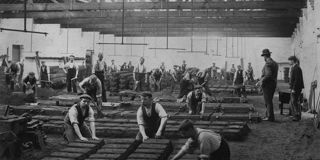Museum collections
The Collections at the Ironbridge Gorge Museum Trust (IGMT) total more than 400,000 objects and includes buildings and monuments, as well as collections relating to the decorative arts, industry and engineering, local history, transport, and natural history.
All of the Ironbridge Gorge Museum Trust's Collections are designated as being of national significance by Arts Council England and can be accessed by anyone for free.
-
![The Coalbrookdale Company Orders Archive]()
Our collections
Our Collections include objects, costume, and archives, as well as a reference library which covers a wide range of subjects relating to the Ironbridge Gorge World Heritage Site, its people, industries and landscapes.
Learn more
-
![The Lives Of Disabled Workers In The East Shropshire Coalfield]()
Our stories
Delve deeper into the history of the Ironbridge Gorge World Heritage Site and the lives of the people who lived and worked here.
Discover more
-
![Cataloguing Documents Ironbridge Museum Trust Archive 001]()
Our services
Do you have a question for the Collections Team? Would you like to donate an item? Or enquire about our research facilities?
Find out more
NOTICE: We are currently carrying out a major repair programme on the Long Warehouse in Coalbrookdale which houses the Museum Library and Archives. Work will include removing asbestos sheeting and completely re-roofing the building and it will therefore be necessary to close access to the Library and Archives until August 2025.
During the closure period we will endeavour to continue to respond to enquiries but as staff will not have access to the Collections, we may not be able to respond to all research requests until the works are completed.
We apologise for any inconvenience this causes.

Sign up to our mailing list
Register your email with us and we’ll keep you up-to-date with news, events and offers.



